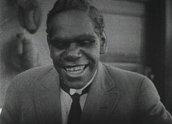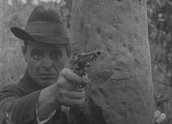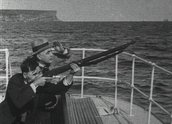


The Enemy Within (1918)
Synopsis
Late in the First World War, Jack Airlie (RL 'Snowy’ Baker) is recalled secretly to Australia after four years of 'special duty’ abroad. He returns to enthusiastic merriment at his gentleman’s club and society parties thrown by his oldest friend, Mrs Drew (Lily Rochefort). Jack notes that her daughter Myee (Lily Molloy) is now a beautiful young woman. Rich businessman Henry Brasels (John Faulkner) has his eye on her, but Jack soon discovers that Brasels is running a gang of German sympathisers and saboteurs. The gang leader is Bill Warne (Billy Ryan), a radical agitator who’s planning to set off a series of bombs in the city. Brasels lures Jack into a trap. He escapes with the aid of his Aboriginal sidekick, detective Jimmy Cook (Sandy McVea). They pursue Brasels and Warne to the northern beaches of Sydney, where there is a bush shootout. Brasels drugs and kidnaps Myee, intending to take her as a hostage, while he boards a German ship. Jack descends a steep cliff to rescue her, as the Coastal Patrol catches up with Brasels and Warne. Jack asks Myee to marry him.
Curator’s notes
The Enemy Within was Reginald Leslie (‘Snowy’) Baker’s first movie, but it is so much more than that, in terms of history. It was Snowy Baker’s attempt to regain the public’s trust in Australia, after his name was blackened by the death of the boxer Les Darcy. It was also a political movie – part of the ongoing battle between left and right over conscription and Australia’s part in the First World War. The thing it wasn’t, according to its backers, was a war picture, because the public by late 1917 had stopped going to war pictures. The rising casualty lists from the Western Front and the bruising national controversy over conscription referenda had made the war box-office poison, where two years earlier it had been a goldmine (see The Hero of the Dardanelles, 1915).
Australia had voted no to Billy Hughes’s first referendum on compulsory conscription on 28 October 1916, by a margin of 48 per cent for and 52 per cent against. A second referendum, couched in simpler (and arguably dishonest) terms, was set for 20 December 1917, exactly the time that The Enemy Within was in production. Clearly, the movie could not have been intended to directly influence public opinion in that referendum, but it’s obvious that it was made partly as a (somewhat crude) response to the General Strike of July and August 1917, and the perceived influence of the Industrial Workers of the World (the IWW, or ‘Wobblies’) within Australia’s anti-war movement.
There is an intriguing question about the film’s financial backing. In his book on Snowy Baker, Sydney journalist Greg Growden writes that one of Baker’s brothers, Frank Baker, recalled ‘many decades later’ that the film was made ‘for the government’ (see The Snowy Baker Story, 2003). The writer and director of the film was Roland Stavely, a stage producer for JC Williamson’s, who had entered into film production in 1914 to protect their own plays from being filmed by others. In 1915, the Firm (as JC Williamson’s was known) produced Within Our Gates, or Deeds that Won Gallipoli, the second re-creation of the landing at Gallipoli, which also had a story about German spies active in Australia. They plumbed this theme again soon after in For Australia (1915), directed by Monte Luke, but this was not unusual. German traitors in our midst was a frequent theme in Australian wartime production. Curiously, The Enemy Within has no production company credits on the existing copy of the film, which is somewhat unusual. The government led by Billy Hughes was certainly active in its propaganda campaign during 1917. Hughes issued a proclamation before the 1917 vote which compelled theatre owners to show whatever films or slides the government sent them about the referendum, an extraordinary move.
Whether or not the government had a hand in its production, Snowy Baker had his own pressing personal reasons for wanting to do it. One of these was that his principal business, promoting boxing through his interest in the Sydney Stadium, was going broke. The reasons are complex and inevitably speculative. Baker had become a household name in Sydney by 1906, when a thousand people turned out to farewell him as he sailed for England to compete in the Amateur Boxing Association’s championships. By then, he had already played rugby union for Australia, and distinguished himself in running, swimming, diving, fencing, rowing, wrestling, shooting, tent-pegging, riding, cricket and water polo. In the 1908 Olympics in London, he competed in three different sports, winning a silver medal in boxing (as a middleweight).
He returned to Sydney at the end of 1908 a national sporting hero, ambitious to cash in on his achievements. In 1913, he ‘bought’ the Sydney Stadium from colourful entrepreneur Hugh D McIntosh, although both McIntosh and the Melbourne underworld figure John Wren retained secret interests in the business – which was to bring boxers of international stature to fight in Sydney, Melbourne and Brisbane. Before the war, this partnership made a great deal of money. Australia became a boxing mecca, offering the biggest prize money and biggest fights.
In July 1914, they featured a young Australian boxer for the first time at the Sydney Stadium: Les Darcy, from Maitland, New South Wales. Between January 1915 and September 1916, Darcy won 22 consecutive fights, with Snowy Baker orchestrating all aspects of his career (see Les Darcy’s Last Fight: Les Darcy vs George Chip, 1916). Unfortunately, his rise coincided with the start of the First World War, which was inconvenient for both men. Baker made a show of trying to enlist on several occasions, but was refused as unfit because of spinal injuries sustained in a car accident near Manly in March 1915. Journalist Greg Growden calls this attempt to enlist 'a charade’ on Baker’s part. Les Darcy was receiving much criticism for not having joined up already, including white feathers sent through the mail. Darcy was reaching the peak of his career and earning capacity, and had several offers to go to the US and make a fortune. He was also supporting a large family in Maitland.
Snowy Baker was desperate to keep Darcy fighting in Australia for as long as possible, because he was an enormous drawcard. Growden writes that Darcy and Baker made a deal – six fights in six months, after which Darcy would enlist. In August 1916, two years into the war, Baker gave a newspaper interview in which he said he had told Darcy that he would get no more fights with Stadiums Ltd (the company through which Baker operated) unless he enlisted. Darcy had agreed to the condition, Baker said. In fact, Darcy stowed away on a ship out of Newcastle, desperate to get to America. He would die there on 24 May 1917, of complications brought on by septicaemia and endocarditis.
At the time of his death, Snowy Baker was waging a vindictive campaign of letter writing to stop Darcy getting any fights in the US. Some of these letters, to American sports editors, arrived after he was already dead. The backlash against Baker in Australia was intense – partly because the campaign against Darcy, waged also by ‘Huge Deal’ McIntosh and John Wren, had been intense. McIntosh owned The Sunday Times newspaper in Sydney and he used it to vilify Darcy as a traitor, partly because Darcy had ‘run away’ one day before the first conscription referendum. McIntosh was a major supporter of Billy Hughes’s conscription campaign and he used his newspaper to attack the anti-conscriptionists. He was also a major silent partner in the stadium that had been milking Darcy’s fights for every possible shilling in the previous year. Darcy had refused a contract offered by McIntosh himself to fight in America.
When he stowed away – after being refused a passport or permission to leave Australia – Darcy made an enemy of three very powerful men – Baker, McIntosh and Wren. A month before he died, Darcy wrote to Baker apologising for leaving and offering to come back and fight for a few months before going to the front:
To tell you the truth Mr Baker, I did not want to go to the war just then, and I don’t think anybody else in my position would want to go either. I have, as you know, right now a chance of setting my family on their feet for the rest of their lives, and can do it in a short time: then I don’t care what becomes of me … I’ll go to the front but I think I would be a bigger cur if I went to the front and left a starving family at home. The British Army wouldn’t miss me for a few months.
The key word there is ‘British’. Darcy was a Catholic, and the Irish-Catholic working classes in Australia had mixed emotions about fighting what many felt was a British war – especially in the months following the Easter Uprising of 1916 in Dublin. It’s far from clear that Darcy had any direct political objections to the war; what’s more certain is that the politics of the war had a major impact on him – and on Snowy Baker.
After Darcy’s untimely death in Memphis, sentiment in Australia turned against those who had ‘persecuted’ him. Baker was turned away from attending Darcy’s funeral in Maitland, with threats of violence. Baker took the backlash seriously, because it was affecting attendance at his stadium. He even went to a special hearing in Maitland before the Les Darcy Memorial Committee, to answer the charge that he had hounded Darcy to his death. This was in October 1917. The explanation did not stop the haemorrhaging stadium business – it closed in February 1918, but by then Snowy Baker had made his first attempt to transform himself into a movie star.
The Enemy Within was the first of five films he made here before moving to America, of which only two survive – the other being The Man from Kangaroo (1920). This first movie was successful at the box office, and as a vehicle for Snowy Baker’s rehabilitation. Its story seemed less far-fetched then than it does now: the German raider Wolf had been active off the New South Wales coast. It laid mines off Gabo Island that holed the freighter Cumberland in mid-1917.
The film also played heavily on anti-German sentiment which was still rife in Australia. This is perhaps the most ironic element about this story, because Snowy Baker’s family may have had German origins, before the family settled in Ireland. Greg Growden writes that there is some confusion in the family about this, but some believe the Bakers were part of an exodus from the Palatinate region in the early 18th century, fleeing religious persecution. When he married in March 1909, it was at St Mark’s Anglican Church in Darling Point, Sydney.
Baker moved to the USA in August 1920 to pursue a Hollywood film career. He did appear in some movies, but had more success teaching stars to ride. He died in Los Angeles in December 1953.
Secondary curator’s notes
by Liz McNivenThe Enemy Within is the first in a series of five feature films starring Snowy Baker and featuring his superior athletic ability, but this film holds great significance for another reason. For over 70 years The Enemy Within stood alone in its non-stereotypic characterisation of Aboriginality. The film cast an Aboriginal man, Sandy McVea, in the non-racialised role of detective Jimmy Cook, and includes the Aboriginal actor and his character in the film’s credits.
In this spy story Baker plays Jack Airlie, a secret service agent brought in to bust a ring of foreign agents before they infiltrate Australian society and undertake subversive activities. The head of the agency introduces Jack to his assistant on the case, Jimmy Cook. The two men, assigned to destroy the ‘enemy within’, form a good partnership founded on a trusting friendship.
McVea’s character, Jimmy Cook, is central to the storyline as he uses both his traditional skills and professional training to track the villain through bushland, locate the enemy hide-out in the city, save his partner at critical points and to help him rescue his sweetheart.
In the 1970s, Arthur Upfield’s Bony novels provided the Australian small screen with the character Napoleon Bonaparte, an Aboriginal detective. The television series Boney (1971–73) however cast a New Zealand actor in the role rather an Australian Aboriginal actor. It wasn’t until 1999 when Aaron Pedersen played detective Michael Reilly in Water Rats (1996–2001), broadcast by the Nine Network, that the Australian screen cast an Aboriginal actor to play a non-racialised role.
The Enemy Within was many decades ahead of its time in its representation of Aboriginality. Both Snowy Baker and Sandy McVea were elite sportsmen in their day and knew each other before making the film. McVea embodied, humanised and fleshed out the character of Jimmy Cook. It’s a real gem of early Australian cinema and I recommend this film to people with an interest in silent films, early Australian spy films, or in the representation of Aboriginality on the Australian screen.
- Overview
- Curator’s notes
- Video 3 clips
- Principal credits
- Find a copy
- Make a comment
- Map
- Extras
- Add your review




